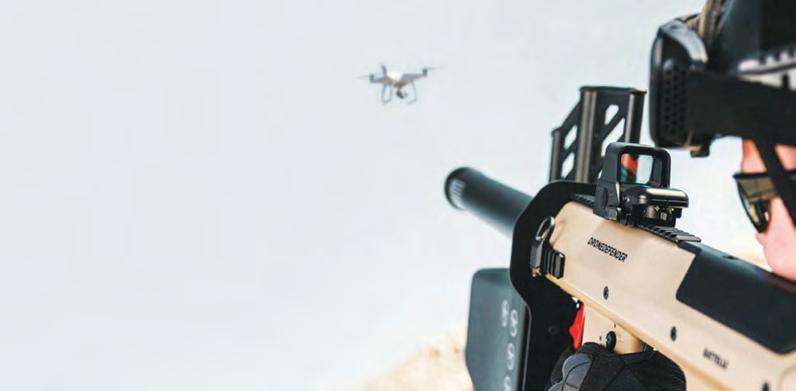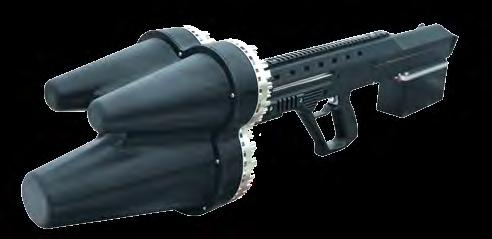
6 minute read
Anti-drone warfare
Anti -dron e hand -he gun s
Russia-sponsored separatist insurgents fighting government forces in Donbas, eastern Ukraine, have extensively deployed drones and unmanned aerial vehicles (UAVs), both for battlefield surveillance and for artillery fire adjustment roles. This has driven Ukrainian industries, specifically UkrSpecTechnika, Proximus LLC, and InterProInvest LLC among others, to launch projects for development and production of air defense countermeasures required by the Ukrainian Armed Forces and the National Guard. With this purpose in mind, and given the trends going on in the international UAV market, the Ukrainian companies opted for solutions such as anti-drone jamming guns that neutralize UAV threats by disrupting their GPS and C2 datalinks.
Advertisement
Wha is an anti -dron e gun ? Counter Unmanned Aerial Vehicles (C-UAV), or anti-drone weapons and guns are any of a range of countermeasures designed to immobilize a target drone by jamming its remote control and GPS datalinks. They can come in the form of handheld weapons akin to traditional projectile guns, to larger artillery-scale devices which are differentiated by size, the number of personnel involved, and operational range among other characteristics.
UAVs are currently commercially available in many countries, and this is what is driving this market up. The converse of this is that individual persons, or groups thereof, can use drones for malicious or nefarious activities involving, for example, delivery of contraband, narcotics, or banned food to prisoners, or breach of security to take photos or record video footage. For this reason, governments in those countries had challenged their industries to produce countermeasures against the threats small commercially available UAVs can pose. This led to emergence of anti-drone hand-held guns.
The U.S. is leading this market with products such as DroneGun Tactical (by DroneShield), DroneDefender (by Battelle), and Skywall100 (anti-drone bazooka by OpenWorks).
In Russia, there is the counter-UAV gun Rex-1 by Kalashnikov (which made its first public appearance at the defense expo Army-2017) and its more recent iteration, the Rex-2 that was unveiled at the Army-2019 expo. There is no information on whether or not Russian-produced Rex-series anti-drone guns have been deployed and
used in military operations in eastern Ukraine and Syria, but it’s likely they have been there, given the extensive use of commercial UAVs in those conflicts.
The design & development company Radar, Belarus, has produced the counter-UAV jammers Groza-S and Groza-R.
In Germany, H.P. Martketing & Consulting Wust GmbH has developed the HP 47 Counter UAV Jammer that was seen used at World Economic Forum Annual Meeting 2017 in Davos, Switzerland, while Aeronautica SDLE, Spain, offers its Aeronautica Anti-drone system.
The Turkish company Aselsan has developed its own anti-drone solution, the IHASAVAR that was introduced at the 2017 Arms & Security Expo held in Kyiv.
Ukr aini an Solution s Over the five years of military hostilities in its Donbas region Ukraine has gained an extensive experience

InterProInvest introduced its RIFF-P Anti-Drone Gun at the 2019 Arms & Security Expo held in Kyiv in October
in countering a wide range of drone threats and in using own UAV capabilities against the adversary. This experience provided Ukrainian industries valuable insights into how a domestically developed counter-UAV weapon should look like. There have been created three anti-drone jamming guns that, while introduced in different years at different expos, have retained their relevance and conformity to current trends.
InterProInvest revealed its counter drone technology, the RIFF-P, at the 2019 Arms & Security Expo held in Kyiv in October. A man-portable system, the RIFF-P is specifically designed to defeat rotary-wing drones (quadcopters and gexacopters) and flying/fixed-wing UAVs.
Defense and public security services can use the RIFF-P for protection of critical infrastructures, military bases and checkpoints, and for support of border security missions. The RIFF-P technology is also suitable for protection of public events, whatever the size or the scope. The gun has a bullpup design that makes it look like the automatic rifle Malyuk, another product by InterProInvest. Weighing just 5.8 kg, the RIFF-P is portable and usable by one person without assistance. It can disrupt GNSS signals over up to 1.5 km and jam UAV remote control signals and video signals at ranges up to 0.9 km. The weapon has enough power to run continuously for 1 hour (or longer with additional rechargeable batteries which are provided as optional extras).
It’s worth of note that anti-drone guns almost all belong to a sub-category of directed energy weapons, and the RIFF-P is no exception. The system is a shoulder mounted jammer with a directional antenna that covers a 20-degree sector, emitting 100-W RF jamming power on four bandwidths and 200-W power on six bandwidths. A one-button-press-system enabling easy and rapid deployment, the RIFF-P jammer works by disrupting the connection between the target drone and its pilot’s controls and by jamming GNSS (GPS/GLONASS/Galileo/Beidou) signals.
The RIFF family of anti-drone jammers consists of several different models ranging from a conventionally configured shotgun to the RIFF-S and RIFF-M systems optimized for fixed and mobile uses, respectively.
UkrSpecTechnika, a Private JointStock Holding Company, introduced its Anti-UAV Gun at the 2017 Arms & Security Expo held in Kyiv. The weapon would have utility to prevent commercial UAVs being used for subversive or terrorist attacks or crimes against privacy. It is suitable to provide protection for both civilian and military targets of whatever size.
UkrSpecTechnika, which is more renowned for its products for defense and military use, developed its Anti-UAV Gun with an eye to civilian needs, especially security protection of highly populated events.
UkrSpecTechnika’s Anti-UAV Gun employs a directional antenna that can reach up to 2,000 m, but the ad
ator, the Jammergun 3 interrupts the link between drone and pilot and its navigation, and, like its counterparts as described above, is suitable to be used for security protection of civilian and military targets.
Featuring three directional waveguide antennas and weighing 10 kg, the Jammergun 3 is able to reach 0.1- 0.6 km away and to work continuously during 30 min. It is carried in a backpack, which has pockets for accessories and provides ease of use for the operator. The backpack is integrated with a cooling system, and protects from water and dirt getting inside.
The directional antennas are mounted on a dedicated Picatinny rail that can also mount a "red dot" collimator sight to facilitate more accurate aiming.
Anti-UAV Gun, product by the Ukrainian company PrAT "Holding Company Ukrspectechnika"

dition of optional omni-directional antennas would provide a 360-degree, extended range GNSS (GPS/ GLONASS) jamming capability of up to 5 km. The Anti-UAV Gun can run continuously for 8 hr.
The Anti-UAV Gun developer points out that the system with its low weight is one-person portable in a transport case or, alternatively, can be transported on a quad bike, motor vehicle or other conveyance.
Jammergun 3 by Conus Research & MFG. At the 2018 Arms & Security Exhibition, Ukraine’s Conus Research & MFG Company unveiled the first release of its anti-drone gun Jammergun 3.
Portable enough to be carried in a backpack and used by a single operFive years of the "hybrid" aggressive war being waged by Russia in Ukraine have driven Ukraine’s air defense industry to develop, grow and to adopt new technologies and processes. Not only are Ukrainian industries keeping pace with current trends going on in the global arms market, but can offer competition in this market. The anti-drone weapons as described above are only the first buds of this emerging branch of the air defense industry in Ukraine, and this gives hope that those Ukrainian products would not go unnoticed by potential customers in Ukraine and beyond.
Denis Ponomarenko , Defense Express











